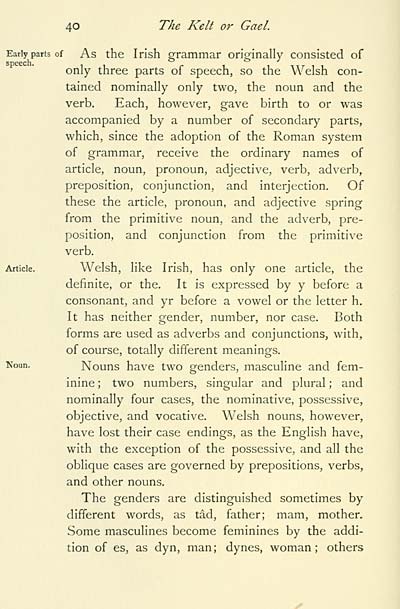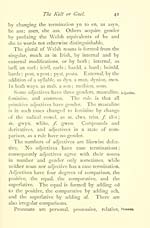Blair Collection > Kelt or Gael
(44)
Download files
Complete book:
Individual page:
Thumbnail gallery: Grid view | List view

40 The Kelt or Gael.
Early parts of As the IHsh grammar originally consisted of
only three parts of speech, so the Welsh con-
tained nominally only two, the noun and the
verb. Each, however, gave birth to or was
accompanied by a number of secondary parts,
which, since the adoption of the Roman system
of grammar, receive the ordinary names of
article, noun, pronoun, adjective, verb, adverb,
preposition, conjunction, and interjection. Of
these the article, pronoun, and adjective spring
from the primitive noun, and the adverb, pre-
position, and conjunction from the primitive
verb.
Article. Welsh, like Irish, has only one article, the
definite, or the. It is expressed by y before a
consonant, and yr before a vowel or the letter h.
It has neither gender, number, nor case. Both
forms are used as adverbs and conjunctions, with,
of course, totally different meanings.
Noun. Nouns have two genders, masculine and fem-
inine ; two numbers, singular and plural ; and
nominally four cases, the nominative, possessive,
objective, and vocative. Welsh nouns, however,
have lost their case endings, as the English have,
with the exception of the possessive, and all the
oblique cases are governed by prepositions, verbs,
and other nouns.
The genders are distinguished sometimes by
different words, as tad, father; mam, mother.
Some masculines become feminines by the addi-
tion of es, as dyn, man; dynes, woman; others
Early parts of As the IHsh grammar originally consisted of
only three parts of speech, so the Welsh con-
tained nominally only two, the noun and the
verb. Each, however, gave birth to or was
accompanied by a number of secondary parts,
which, since the adoption of the Roman system
of grammar, receive the ordinary names of
article, noun, pronoun, adjective, verb, adverb,
preposition, conjunction, and interjection. Of
these the article, pronoun, and adjective spring
from the primitive noun, and the adverb, pre-
position, and conjunction from the primitive
verb.
Article. Welsh, like Irish, has only one article, the
definite, or the. It is expressed by y before a
consonant, and yr before a vowel or the letter h.
It has neither gender, number, nor case. Both
forms are used as adverbs and conjunctions, with,
of course, totally different meanings.
Noun. Nouns have two genders, masculine and fem-
inine ; two numbers, singular and plural ; and
nominally four cases, the nominative, possessive,
objective, and vocative. Welsh nouns, however,
have lost their case endings, as the English have,
with the exception of the possessive, and all the
oblique cases are governed by prepositions, verbs,
and other nouns.
The genders are distinguished sometimes by
different words, as tad, father; mam, mother.
Some masculines become feminines by the addi-
tion of es, as dyn, man; dynes, woman; others
Set display mode to: Large image | Transcription
Images and transcriptions on this page, including medium image downloads, may be used under the Creative Commons Attribution 4.0 International Licence unless otherwise stated. ![]()
| Early Gaelic Book Collections > Blair Collection > Kelt or Gael > (44) |
|---|
| Permanent URL | https://digital.nls.uk/75787168 |
|---|
| Description | His ethnography, geography and philology. |
|---|---|
| Shelfmark | Blair.17 |
| Additional NLS resources: | |
| Attribution and copyright: |
|
| Description | A selection of books from a collection of more than 500 titles, mostly on religious and literary topics. Also includes some material dealing with other Celtic languages and societies. Collection created towards the end of the 19th century by Lady Evelyn Stewart Murray. |
|---|
| Description | Selected items from five 'Special and Named Printed Collections'. Includes books in Gaelic and other Celtic languages, works about the Gaels, their languages, literature, culture and history. |
|---|

